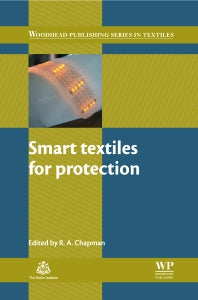Freshly Printed - allow 10 days lead
Couldn't load pickup availability
Smart Textiles for Protection
R Chapman (Edited by)
9780857090560, Elsevier Science
Hardback, published 10 December 2012
416 pages
23.4 x 15.6 x 2.7 cm, 0.76 kg
Smart textiles are materials and structures that sense and react to environmental conditions or stimuli, and their integration into protective clothing has led to the development of products with greatly enhanced protective capabilities in hazardous situations. Smart textiles for protection provides a comprehensive analysis of smart materials used in producing protective textiles, and explores a wide range of end-use protective applications.
Part one reviews smart materials and technologies. Beginning with an overview of smart textiles for protection, this section goes on to discuss types of materials, surface treatments and the use of nanofibres and smart barrier membranes. The application of sensors, actuators and computer systems in smart protective textiles is explored, followed by a review of biomimetic approaches to design. Part two investigates specific applications of smart textiles for protection. Smart technology for personal protective equipment and clothing, smart protective textiles for older people and smart high-performance textiles for protection in construction and geotechnical applications are all discussed in depth, as is the use of smart textiles in the protection of armoured vehicles and in protective clothing for fire fighters and first responders. The final chapter describes recent advances in chemical and biological protective clothing.
With its distinguished editor and international team of expert contributors, Smart textiles for protection is an essential guide for all those involved in the design, development and application of protective smart textiles.
Contributor contact details Woodhead Publishing Series in Textiles Part I: Smart materials and technologies Chapter 1: Smart textiles for protection: an overview Abstract: 1.1 Introduction 1.2 Smart textile functions for protection 1.3 European projects on smart protective textiles 1.4 Protective textiles and comfort 1.5 Other functions of smart textile systems 1.6 Systex – a European coordination action for enhancing the breakthrough of intelligent textile systems Chapter 2: Types of smart materials for protection Abstract: 2.1 Introduction: smart materials for protection 2.2 High-performance fibres for protective textiles 2.3 Piezoelectric fibres, phase-change materials, and shape memory fibres 2.4 Woven and knitted structures for protective textiles 2.5 Nonwovens 2.6 Barrier films and nanofibre membranes 2.7 Carbon nanotubes 2.8 Conclusion and future trends Chapter 3: Smart surface treatments for textiles for protection Abstract: 3.1 Introduction: the role of surfaces in smart fabrics for protection 3.2 Surface grafting 3.3 Coating techniques 3.4 Other surface treatment methods 3.5 Conclusion and future trends Chapter 4: The use of nanomaterials in smart protective clothing Abstract: 4.1 Introduction 4.2 Conventional materials used in protective clothing 4.3 Use of nanoparticles in protective clothing 4.4 Use of electrospun nanofibers and nanoparticles in protective clothing 4.5 Applications of nanoparticles in protective textiles 4.6 Smart textiles using nanoparticles 4.7 Chameleon fibers 4.8 Conclusion and future trends 4.9 Sources of further information and advice Chapter 5: Smart barrier membranes for protective clothing Abstract: 5.1 Introduction 5.2 Principles and types of responsive barriers 5.3 Principles and types of self-decontaminating barriers 5.4 Advantages and challenges of responsive and self-decontaminating barriers 5.5 Applications of responsive and self-decontaminating barriers 5.6 Conclusion and future trends 5.7 Sources of further information and advice 5.8 Acknowledgments Chapter 6: Sensors, actuators and computing systems for smart textiles for protection Abstract: 6.1 Introduction 6.2 When textiles meet electronics 6.3 Sensors in textiles 6.4 Actuators in textiles 6.5 Power 6.6 Networks 6.7 Future trends 6.8 Design case study: neonatal monitoring 6.9 Sources of further information and advice Chapter 7: Biomimetic approaches to the design of smart textiles for protection Abstract: 7.1 Introduction: smart material design in nature 7.2 Biomimicry of smart protective textiles 7.3 Conclusion and future trends 7.4 Acknowledgements Part II: Applications of smart textiles for protection Chapter 8: Smart technology for personal protective equipment and clothing Abstract: 8.1 Introduction 8.2 Types of personal protective equipment and clothing 8.3 Applications of smart clothing in personal protective equipment 8.4 Conclusion and future trends 8.5 Sources of further information and advice Chapter 9: Smart protective textiles for older people Abstract: 9.1 Introduction 9.2 The demands of the changing body 9.3 The clothing layering system 9.4 Smart protective textiles for older people 9.5 Usability of the technology interface 9.6 Conclusion 9.7 Sources of further information and advice Chapter 10: Smart high-performance textiles for protection in construction and geotechnical applications Abstract: 10.1 Introduction 10.2 Technical textiles for the construction and geotechnical sectors 10.3 Incorporating sensors into smart textiles through the use of optical fibres 10.4 Applications of smart textiles in construction 10.5 Future trends: the Industrial Smart Materials Applications (ISMA) initiative 10.6 Sources of further information and advice Chapter 11: Smart textiles for the protection of armoured vehicles Abstract: 11.1 Introduction 11.2 Understanding impact behaviour 11.3 Bullet-proof textile composites for armoured vehicles 11.4 Using sensor networks in composites to measure impact behaviour and material performance in situ 11.5 Conclusion 11.6 Future trends Chapter 12: Protective clothing for firefighters and rescue workers Abstract: 12.1 Introduction 12.2 The Protection e-Textiles (PROeTEX) project 12.3 Other firefighter-related European projects 12.4 Simulation of the firefighter market 12.5 The Viking fire protection suit with built-in thermal sensor technology 12.6 The Tecknisolar firefighter garment 12.7 Conclusion Chapter 13: Advances in chemical and biological protective clothing Abstract: 13.1 Introduction 13.2 Current chemical and biological (CB) protective clothing 13.3 Materials for chemical and biological (CB) protective clothing 13.4 Technologies for next generation chemical and biological (CB) clothing Index
Subject Areas: Textile & fibre technology [TDH], Plastics & polymers technology [TDCP], Biomedical engineering [MQW]


